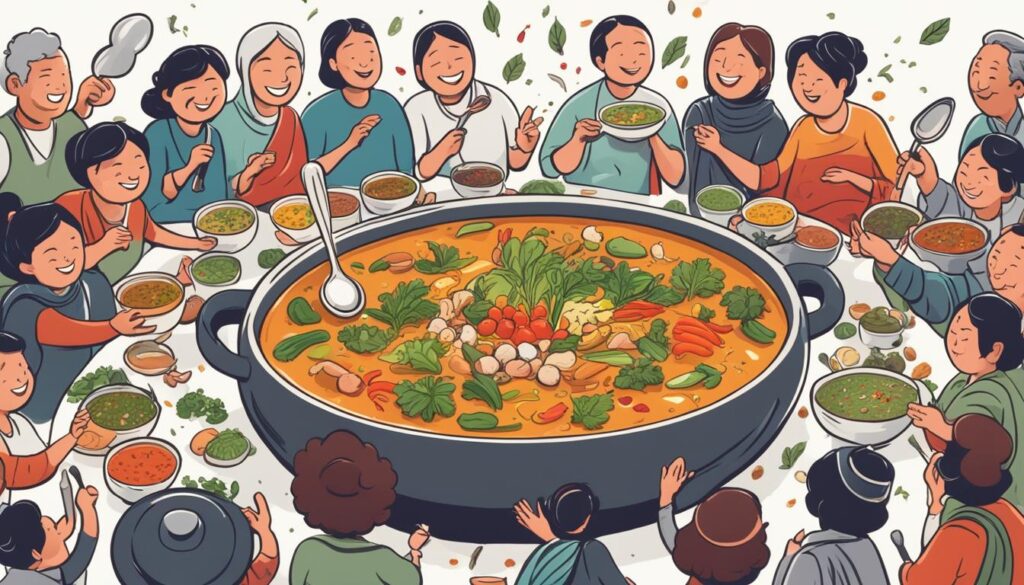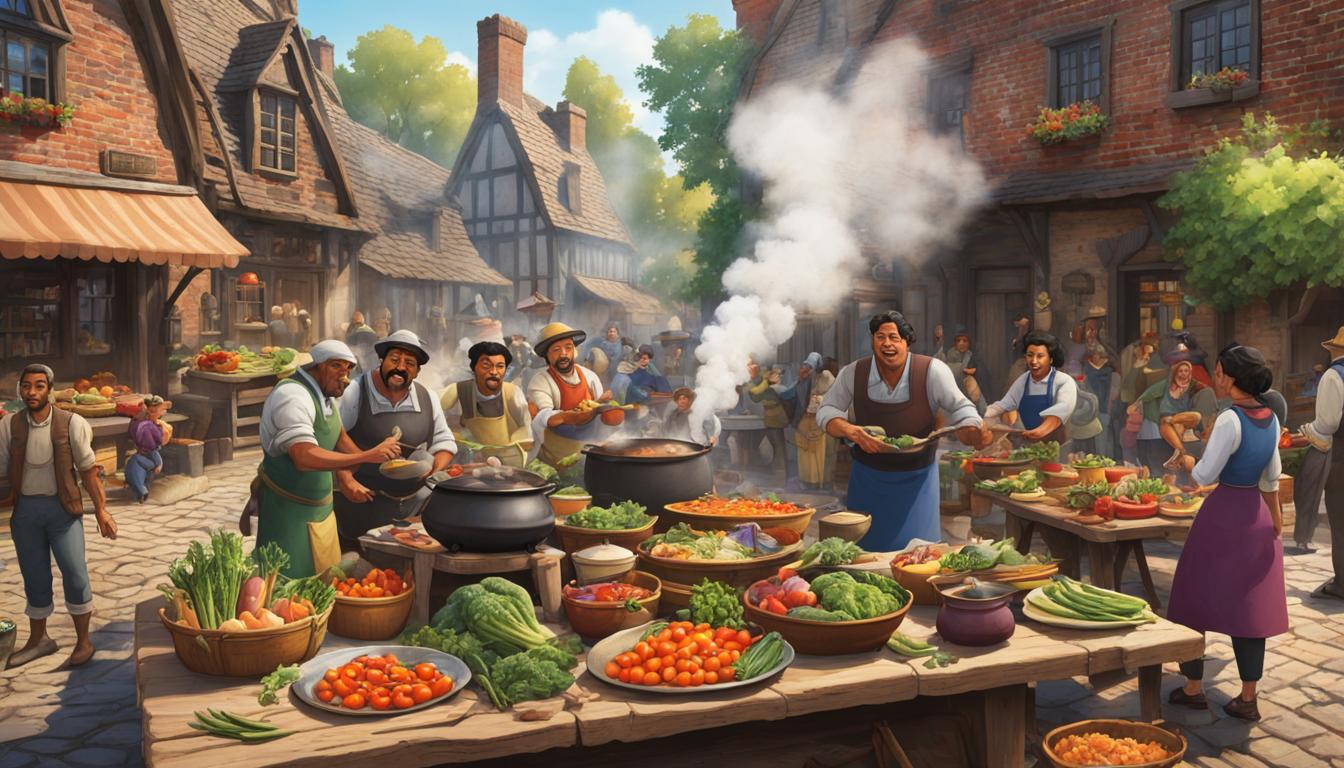Stone Soup, a classic children’s book written and illustrated by Jon J. Muth, teaches us about the power of community, sharing, and the kindness of strangers. The heartwarming story follows three monks who, with just a small stone and some ingenuity, create a delicious meal that brings the whole village together.
In this book summary, we will take a closer look at Stone Soup, examining its plot, characters, themes, and illustrations. We will also explore the book’s reception and its lasting impact on readers, as well as the valuable lessons it imparts.
Key Takeaways
- Stone Soup teaches us the importance of sharing and community.
- Jon J. Muth’s illustrations in Stone Soup are beautiful and enhance the storytelling experience.
- The book has had a significant impact on children’s literature since its release.
- Valuable lessons from the story include the importance of kindness and the power of strangers to become friends.
- The heartwarming message of Stone Soup continues to resonate with readers of all ages.
Introduction to Stone Soup
Stone Soup is a classic children’s story that teaches the value of sharing and community. Written and illustrated by Jon J. Muth, the book has been a beloved favorite for decades and continues to inspire readers of all ages.
In this section, we will provide a brief summary of the book, exploring its central theme and discussing Muth’s unique approach to storytelling.
“The story of Stone Soup is a timeless reminder that we can achieve great things when we work together and share what we have. It is a beautifully written and illustrated book that captures the essence of community spirit and generosity of heart.”
The Plot of Stone Soup
In “Stone Soup,” Jon J. Muth weaves a heartwarming tale about the transformative power of community and sharing. The story centers around three monks who enter a small village, seeking food and shelter. However, the villagers, who are initially wary and guarded, refuse to offer them any assistance. Undeterred, the monks hatch a plan to make a delicious soup using only a stone and a little water.
“With enough hot water and a stone, you can make a soup from absolutely nothing,” one of the monks declares.
The monks proceed to boil the stone in a pot in the town square, attracting the curiosity of the villagers. As they watch, each villager is convinced to contribute one ingredient to the soup, such as carrots, potatoes, and other vegetables. Soon, a delicious soup is prepared, and everyone in the village comes together to share the meal, forging new bonds of friendship and community in the process.
The story ends with the monks continuing on their journey, leaving behind a village that is forever changed by their visit and the lesson they taught about the power of sharing and coming together.
Key Events:
| Event | Description |
|---|---|
| The Monks Arrive in the Village | The three monks enter the village seeking food and shelter from the villagers, who are hesitant to help. |
| The Stone Soup Plan | The monks concoct a plan to make soup from a stone and water, attracting the attention and curiosity of the villagers. |
| Contributing Ingredients | Each villager is convinced to contribute one ingredient to the soup, creating a communal dish that everyone can enjoy. |
| Sharing the Soup | The villagers come together to share the soup and forge new bonds, united by the simple act of sharing. |
| The Monks’ Departure | The monks continue on their journey, leaving behind a village that is forever changed by their visit and the powerful message they imparted. |
The Characters in Stone Soup
Stone Soup by Jon J. Muth features a cast of memorable characters who play a vital role in the story’s message of empathy and community building. From the wise and mysterious monk to the skeptical townspeople, each character’s motivations and actions contribute to the book’s powerful message.
The Monk: The monk is the catalyst for the story’s events, introducing the idea of Stone Soup to the villagers and demonstrating the power of sharing and cooperation.
The Villagers: The villagers are initially distrustful of the monk and hesitant to share their resources. However, as the story progresses, they learn to work together and discover the benefits of cooperation and generosity.
The Little Girl: The little girl is one of the few characters who offers the monk something to contribute to the Stone Soup, setting an example for others to follow. Her actions demonstrate the importance of kindness and the impact that small gestures can have.
The Mayor: The mayor is initially skeptical of the monk’s plan but eventually realizes the benefits of working together and shares his resources with the community. His transformation highlights the power of empathy and the importance of looking beyond one’s own self-interest.
“Each character’s journey in Stone Soup emphasizes the importance of compassion, empathy, and community building. Through their experiences, readers are reminded of the transformative power of generosity and the impact that small actions can have on those around us.”
Themes Explored in Stone Soup
Stone Soup is a touching narrative that brilliantly illustrates the beauty of community and the boundless power of sharing. One of the main themes in the book is the importance of coming together and pooling resources, even in the face of strife and difficulties. The notion of sharing serves as a driving force throughout the story, exemplifying the heartwarming impact of helping and supporting one another.
Another essential theme in Stone Soup is the idea that people should be judged by their actions, not their appearance. Throughout the book, there are many instances where characters make assumptions about others, based solely on their superficial traits or identity. However, the beauty of the book lies in the way it defies these stereotypes and emphasizes the goodness that lies within everyone, regardless of their background or circumstances.
One of the most profound themes in Stone Soup is the unifying power of food. Throughout history, food has brought people together, bridging social divides, and creating connections that last a lifetime. In the book, the act of making a meal together serves as a metaphor for the power of community, illustrating the transformative impact of working towards a common goal, and sharing in the joys of success.
Stone Soup explores some significant themes that are just as relevant today as when the book was first published. It offers a poignant reminder of the importance of building communities and the incredible change that can result from coming together and sharing resources.

Illustrations in Stone Soup
Stone Soup is widely regarded for its beautiful illustrations, which are integral to the storytelling experience. Illustrator Jon J. Muth masterfully brings the characters and the narrative to life through his captivating artwork.
Muth’s illustrations in Stone Soup are defined by their unique, watercolor style. Every page is rich with intricate details that enhance the reading experience and provide additional layers of meaning to the story. The colors are muted yet still vibrant, and the characters are expertly drawn with subtle nuances that emphasize their personalities.
The illustrations also play a pivotal role in advancing the story by visually communicating certain plot points and themes. For example, the image of the villagers working together to create the soup conveys the power of collaboration and the importance of community building.
One of the most significant illustrations in the book is the image of the soldiers observing the soup-making process. This image showcases the book’s central message of the kindness of strangers and how it creates a powerful ripple effect that inspires others to act in kind.
Muth’s artwork truly enhances the storytelling experience in Stone Soup, making it a classic book that continues to resonate with readers of all ages.
Reception and Impact of Stone Soup
Stone Soup has captured the hearts of readers worldwide, earning critical acclaim and numerous awards since its release. The book has been celebrated for its uplifting message of sharing and community, as well as its stunning illustrations.
The impact of Stone Soup is evident in the countless readers who have adopted its message of generosity and kindness in their lives. The book has become a beloved classic, inspiring individuals of all ages to make a positive impact in their communities.
Book Reviews
“Stone Soup is a shining example of the power of generosity and community. This heartwarming tale will leave readers feeling inspired and uplifted.” – The New York Times Book Review
“Jon J. Muth’s beautiful illustrations perfectly complement the timeless message of Stone Soup, making it a must-read for anyone seeking a meaningful and enriching reading experience.” – BookPage
Impact on Children’s Literature
Stone Soup has had a lasting impact on the landscape of children’s literature, influencing generations of readers and writers alike. By promoting the values of sharing, kindness, and community, Stone Soup has helped shape the genre, demonstrating the power of storytelling in shaping society.
Lessons from Stone Soup
Stone Soup is more than just a heartwarming story – it contains valuable lessons that resonate with readers of all ages. One of the most significant of these is the importance of sharing. The travelers in the story learn that by each contributing a small amount to the collective soup pot, they can create a delicious and nourishing meal for everyone to enjoy. This message speaks to the power of community and the ways in which coming together can create something far greater than the sum of its parts.
Another lesson imparted by Stone Soup is the kindness of strangers. The travelers arrive in a strange town, unaware of what to expect. However, by offering to share what little they have, they are welcomed by the townspeople and provided with a warm place to stay. This reminder of the goodness in people is a particularly valuable lesson in today’s world, where skepticism and mistrust often reign.
The act of sharing is not only beneficial for those on the receiving end – it can also be incredibly rewarding for the giver. By giving to others, we can form meaningful connections and build lasting relationships with those around us. Stone Soup celebrates this community spirit, reminding us of the fundamental importance of cooperating and collaborating with others.
In summary, Stone Soup teaches us that sharing, community building, and the kindness of strangers are all essential components of a fulfilling life. By embracing these values, we can create a better world for ourselves and those around us.
Conclusion
In conclusion, “Stone Soup” by Jon J. Muth is a heartwarming tale that emphasizes the importance of sharing and community. The book’s timeless message continues to resonate with readers of all ages, and its impact on children’s literature cannot be overstated.
Throughout this book summary, we have explored the central themes of the book, delved into its memorable characters, and analyzed the stunning illustrations that bring the story to life. We have also reflected on the lasting impact of “Stone Soup,” both in terms of its reception and the valuable moral lessons it imparts to readers.
Overall, “Stone Soup” is a must-read for anyone who values the power of community, kindness, and generosity. We highly recommend this book to readers of all ages, and we hope that its timeless message will continue to inspire and uplift for many years to come.



